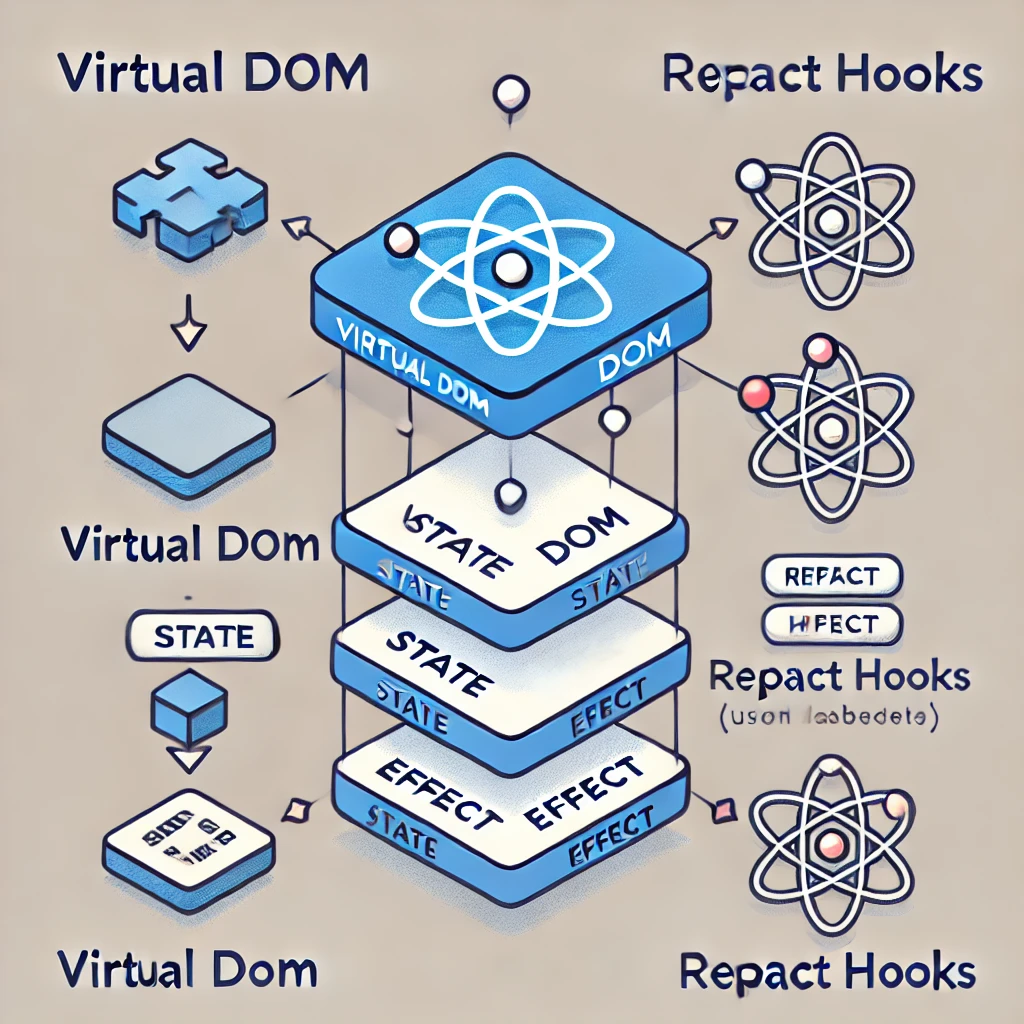Learn React Easily: Beginner-Friendly Guide to Virtual DOM and Hooks
 Md. Masayeakh Islam
Md. Masayeakh Islam
What Are React Hooks? 🤔
Hooks are functions that allow you to "hook into" React features like state and lifecycle methods from function components. They were introduced in React 16.8, allowing function components to handle state, side effects, and other features without the need for class components.
Types of Hooks in React 😵💫
Basic Hooks:
useState: Adds state to function components.
useEffect: Performs side effects (e.g., fetching data, DOM updates).
useContext: Accesses context values without prop-drilling.
useRef: Persists values across renders without triggering re-renders.
useReducer: Alternative to
useStatefor complex state logic.
Additional Hooks:
useMemo: Optimizes performance by memorizing expensive calculations.
useCallback: Memorizes functions to avoid unnecessary re-renders.
useLayoutEffect: Similar to
useEffect, but runs synchronously after DOM mutations.useImperativeHandle: Customizes the instance value exposed via
ref.
How Hooks Work: Code Examples 👨💻
useState - Managing State in Function Components
Purpose: Adds state to function components. Before hooks, state was only available in class components.
import React, { useState } from 'react'; function Counter() { const [count, setCount] = useState(0); // State is initialized to 0 return ( <div> <p>You clicked {count} times</p> <button onClick={() => setCount(count + 1)}>Click me</button> </div> ); }useEffect - Handling Side Effects (e.g., Fetching Data).
Purpose: Executes side effects like data fetching or DOM manipulations after rendering.
It runs automatically when the component mounts or updates.
import React, { useState, useEffect } from 'react'; function DataFetcher() { const [data, setData] = useState(null); useEffect(() => { fetch('https://api.example.com/data') .then(response => response.json()) .then(data => setData(data)); }, []); // Runs once after initial render return ( <div> {data ? <p>Data: {JSON.stringify(data)}</p> : <p>Loading...</p>} </div> ); }useContext - Avoiding Prop Drilling
Purpose: Accesses context values directly, removing the need to pass props down manually at every level (no more "prop drilling").
import React, { useState, createContext, useContext } from 'react'; const ThemeContext = createContext(); function ThemedComponent() { const theme = useContext(ThemeContext); // Access context value directly return <div style={{ background: theme === 'dark' ? 'black' : 'white' }}>Themed Content</div>; } function App() { const [theme, setTheme] = useState('light'); return ( <ThemeContext.Provider value={theme}> <button onClick={() => setTheme(theme === 'light' ? 'dark' : 'light')}>Toggle Theme</button> <ThemedComponent /> </ThemeContext.Provider> ); }useRef - Persisting Values Across Renders
Purpose: Keeps values between renders without causing a re-render. It's often used to store a reference to a DOM element or mutable value.
import React, { useRef } from 'react'; function FocusInput() { const inputRef = useRef(null); // Create a ref to persist the input element const focusInput = () => { inputRef.current.focus(); // Focus the input field }; return ( <div> <input ref={inputRef} type="text" /> <button onClick={focusInput}>Focus the input</button> </div> ); }useMemo - Optimizing Expensive Calculations
Purpose: Memorizes the result of an expensive function to avoid recalculating it unnecessarily on every render.
import React, { useMemo, useState } from 'react'; function ExpensiveComponent({ num }) { const expensiveCalculation = (num) => { console.log('Calculating...'); return num * 2; }; const memoizedValue = useMemo(() => expensiveCalculation(num), [num]); // Re-calculates only when `num` changes return <div>Memoized value: {memoizedValue}</div>; } function App() { const [num, setNum] = useState(1); return ( <div> <ExpensiveComponent num={num} /> <button onClick={() => setNum(num + 1)}>Increment</button> </div> ); }
The Magic of the Virtual DOM ✨
The Virtual DOM is a lightweight copy of the real DOM. React uses it to optimize updates and ensure better performance.
How it Works:
React creates an initial Virtual DOM when the webpage loads.
If any changes occur (state or prop updates), React creates a new Virtual DOM.
React compares the new Virtual DOM with the old one (this process is called "diffing").
Only the changed parts are updated in the real browser DOM, making the updates more efficient.
Real-Life Example of the Virtual DOM 🔄
Think of the Virtual DOM like the drafts of a letter you're writing. Instead of sending the final letter (the real DOM) each time you make a change, you write a draft (Virtual DOM). After you’ve reviewed the draft and confirmed what needs to change, you only send the final version (the real DOM), avoiding unnecessary edits.
Conclusion 🏁
React Hooks and the Virtual DOM are key concepts that simplify development and optimize performance in React. Hooks make functional components more powerful, while the Virtual DOM ensures updates are fast and efficient. Use these tools to create more responsive and scalable applications! 😎
Subscribe to my newsletter
Read articles from Md. Masayeakh Islam directly inside your inbox. Subscribe to the newsletter, and don't miss out.
Written by

Md. Masayeakh Islam
Md. Masayeakh Islam
🌟 Web Developer | Currently learning React and diving into web development step by step. 🚀 Documenting my coding journey, sharing insights, struggles, and breakthroughs. I believe in learning by building—so expect to see small projects and experiments! 🏏 Outside of coding, I’m a huge sports freak who loves football and cricket. Whether it’s cheering for my favorite team, analyzing game strategies, or debating GOATs like Cristiano Ronaldo, sports fuel my passion. 🎮 I’m also into gaming and exploring tech-related topics like secret societies and geopolitics. Let’s grow together—both in code and life!